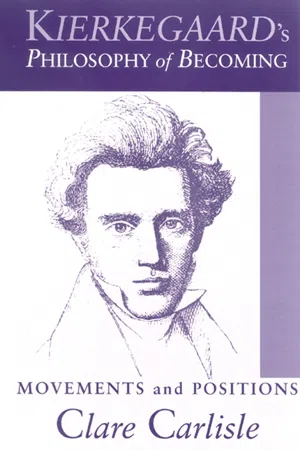
- 186 pages
- English
- PDF
- Available on iOS & Android
About this book
An accessible and original exploration of the theological and philosophical significance of Kierkegaard's religious thought.
Søren Kierkegaard's proposal of "repetition" as the new category of truth signaled the beginning of existentialist thought, turning philosophical attention from the pursuit of objective knowledge to the movement of becoming that characterizes each individual's life. Focusing on the theme of movement in his 1843 pseudonymous texts Either/Or, Repetition, and Fear and Trembling, Clare Carlisle presents an original and illuminating interpretation of Kierkegaard's religious thought, including newly translated material, that emphasizes equally its philosophical and theological significance. Kierkegaard complained of a lack of movement not only in Hegelian philosophy but also in his own "dreadful still life, " and his heroes are those who leap, dance, and make journeys-but what do these movements signify, and how are they accomplished? How can we be true to ourselves, let alone to others if we are continually becoming? Carlisle explores these questions to uncover both the philosophical and the literary coherence of Kierkegaard's notoriously enigmatic authorship.
Frequently asked questions
- Essential is ideal for learners and professionals who enjoy exploring a wide range of subjects. Access the Essential Library with 800,000+ trusted titles and best-sellers across business, personal growth, and the humanities. Includes unlimited reading time and Standard Read Aloud voice.
- Complete: Perfect for advanced learners and researchers needing full, unrestricted access. Unlock 1.4M+ books across hundreds of subjects, including academic and specialized titles. The Complete Plan also includes advanced features like Premium Read Aloud and Research Assistant.
Please note we cannot support devices running on iOS 13 and Android 7 or earlier. Learn more about using the app.
Information
Table of contents
- Kierkegaard’s Philosophy of Becoming: Movements and Positions
- Contents
- Acknowledgments
- Introduction: The Place and the Path
- Part One
- Part Two
- Part Three
- Notes
- Bibliography
- Index